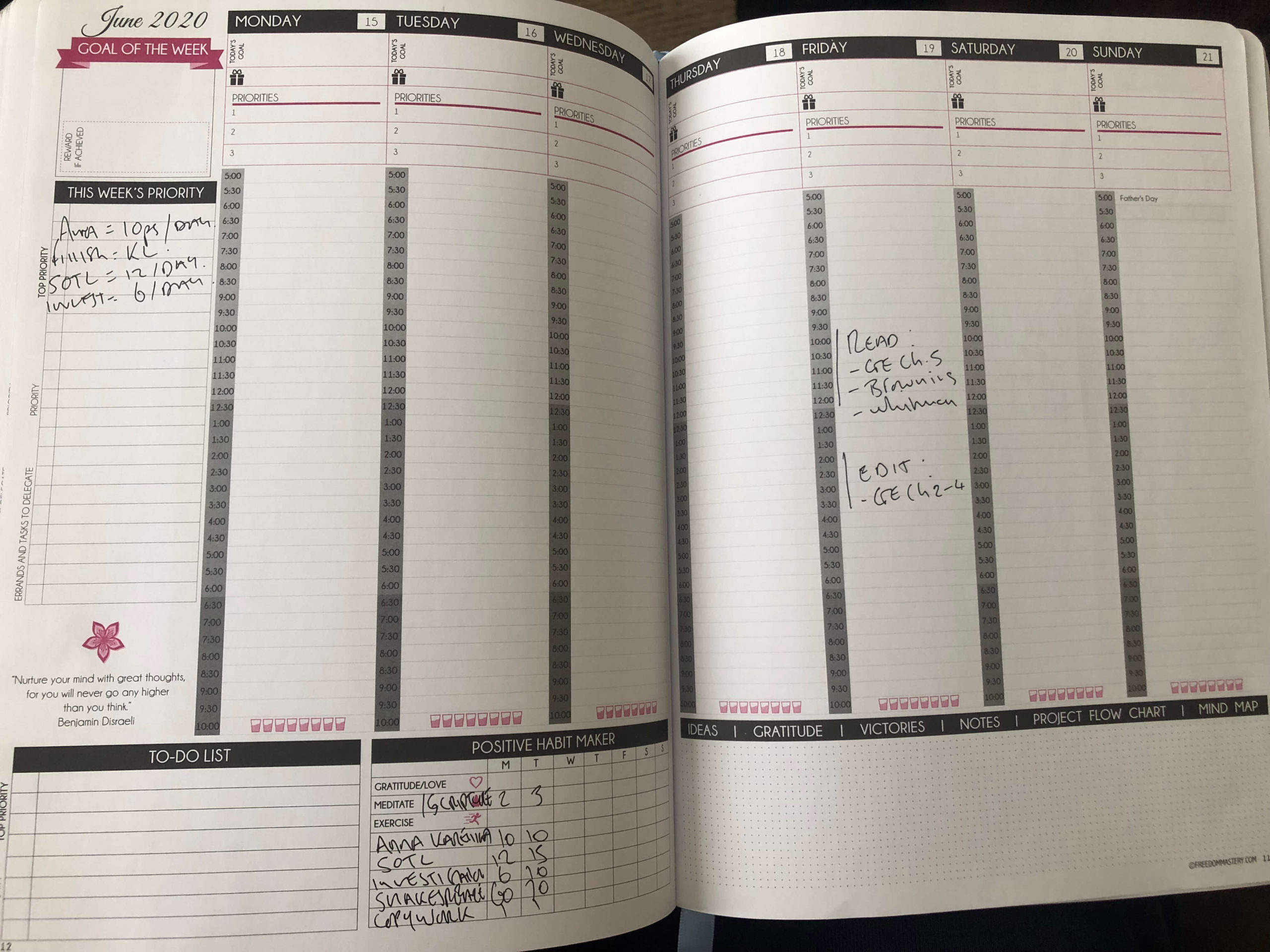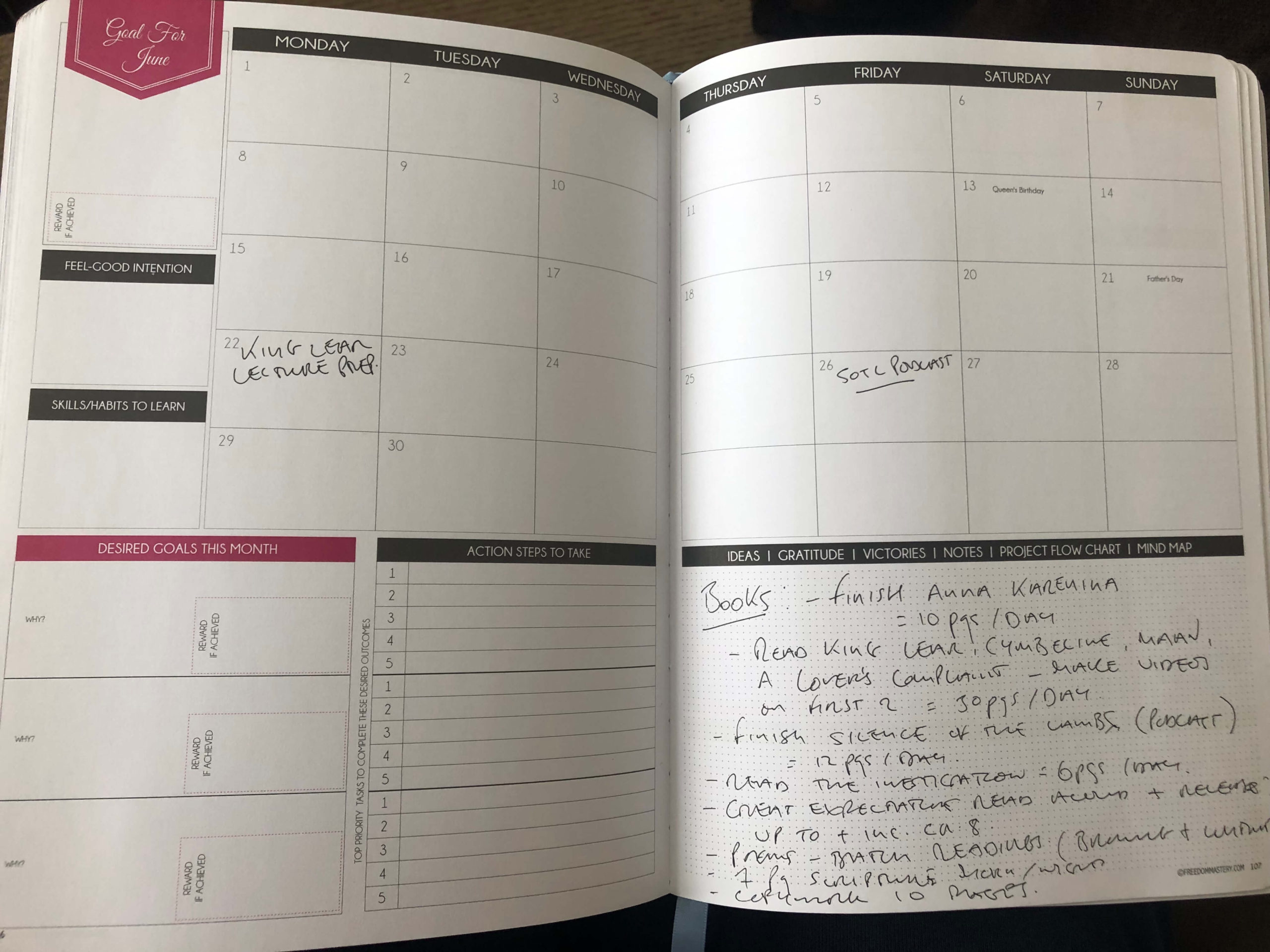I’m going to teach you how to construct your own personal targeted reading plan.
I’ll also give you a peak at my own reading plan creation and show you how to read more books, keep your reading habit consistent, and get even more out of your reading.
You will need:
- A journal – I favour the Freedom Mastery Planner and the Leuchtturm1917 variety; Moleskine is overrated.
- A nice pen – I love the affordable but effective Japanese Muji gel ball point pens in black.
- A thirst for reading, knowledge, and books.
Let’s get into it.
How To Construct Your Own Personal Targeted Reading Plan
What gets measured, gets managed. – Peter Drucker
The key to consistent self-improvement in any realm is efficient, effective, targeted measurement.
- If you want to lose weight or gain muscle, tracking your calories and macros and keeping a workout log where you detail improvements in weight lifted or distance ran is the most beneficial habit you can start.
- If you want to improve as a writer, sticking to a quota, tracking how many words you’ve written each week, and keeping a spreadsheet of what publications you’ve sent your work into is the most valuable habit you can create.
It’s the same with reading.
People marvel at those who read a book a week (52 books a year), or even read a book a day.
But it’s all about breaking things down into manageable chunks.
Many ambitious readers put off tackling Moby Dick because, like War and Peace or Les Misérables, they fear that white whale is too big to tackle.
But Melville’s great novel has 135 chapters. Each chapter’s only a couple of pages. Everybody can manage to read a few pages a day. So if you set aside 10-30 minutes and read a chapter a day, you’ve read Moby Dick in just over four months. Go the extra mile and read two a day, and you’ve tackled that great book in two months.
This works as a study hack too.
Just say you’re feeling overwhelmed by an assignment of 100 pages due next week. Well, break it down. That’s 14 pages per day.
Still overwhelming? How about splitting it morning, midday, and night (which takes advantage of the primacy and recency effect too). Then that’s only 4.5 pages per reading chunk. Easy.
Take a long Sunday afternoon and plan out your month.
I do this with every realm in my life, working from a bigger list of goals.
I’ll do this at the beginning of each month, considering my yearly goals, and I also do this each week, usually on a Sunday evening, and prepare for the week ahead.
I like to start with preparing either:
- My reading goals
- My fitness goals
Both act as scaffolding for everything else, like my business and other personal goals.
If I’m starting with my fitness goals, I usually put mileage for running as I’m aiming to complete a marathon this year, along with a handful of specific weights workouts and yoga sessions.
If I’m starting with my reading goals, I’ll put which books I want to read, break down how many pages per day I need minimum to hit my goals, and anything else related to the goals.

Before I schedule anything else, I schedule my reading. I track page counts of certain works and have goals for the week.
For my book goals, I consider what I’d like to read over the course of a year and why and break them down into a targeted reading plan consisting of 3-4 aims, along with a few subsidiary goals/stretch goals.
My targeted reading plan:
- Rereading the complete works of Shakespeare within one year: that means reading a play per week. I’m doing this reading with a focus on producing a lecture series for Hardcore Literature.
- Read the biggies: Anna Karenina, War and Peace, Les Misérables, Atlas Shrugged, Crime and Punishment, The Iliad. That means reading ~one per month.
- Targeted horror/thriller reading plan: I’m working from a list in order to learn the craft of these specific genres, and these books are supposed to be inhaled.
- Targeted play writing to learn the craft: Once again working from a list in order to learn how to write for the stage, which ties into one of my long-term goals.
Big, exciting, concrete, specific goals with motivation built in – all measurable, trackable, tweak-able, manageable.
My general ethos for directing my book reading, when stripped down completely bare, is that of Jack London’s approach. His reading aim was to read “two good-sized books a week”.
Maybe you don’t want to read the complete works of Shakespeare in a year.
Maybe you want to read the Bible in a year.
Or maybe you want to read a biography of each American president.
Or perhaps you want to get through Mortimer Adler’s Great Books list.
You might even want to deepen your knowledge of a certain craft, hobby, industry, passion – you can learn anything from the history of martial arts to how to appreciate fine art.
All worthy pursuits. All reading goals that are popular across the world wide net with a community of fervent readers.
Come up with a goal that makes YOU personally excited. I can’t tell you what to read (though I certainly have tried).

Books, lecture, and podcast pencilled in before anything else. Then I put fitness stuff. Then business.
Once you’ve detailed a goal that makes you want to run to the library or bookstore with the glee of a child, then comes the really exciting part.
You need to draw up a list of books you want to read.
Again, work with what you think you could reasonably accomplish. If you think you could read a book a week, you could draw up a pretty big TBR list. If you would like to try a book a month, make a list of twelve.
Life’s too short to read books (and drink wine) ad hoc, whatever is spamming the currently bought and bribed bestseller lists.
We want to be stoked to read the next thing on our list.
Here’s my targeted reading lists.
My 10-book horror/thriller reading list
I worked out how many horror novels I could read reasonably comfortably by the end of the year. It turns out to be two per month. So that’s twelve. And, just to be safe, I scaled it down and chose ten:
- The Silence of the Lambs
- The Haunting of Hill House
- Dracula (reread)
- Carrie (reread)
- The Island of Dr. Moreau
- The Girl on the Train
- I Am Legend
- Marathon Man
- Frankenstein (reread)
- The Turn of the Screw
My play reading list
I could comfortably read more plays, on top of the complete works of Shakespeare, as they’re typically slimmer volumes than novels. So I made a dream list of plays I would have been happy to have read.
- Shopping and F*cking
- The Cherry Orchard
- The Importance of Being Earnest
- Who’s Afraid of Virginia Woolf?
- Machinal
- The Resistible Rise of Arturo Ui
- An Inspector Calls (reread)
- A Doll’s House
- Waiting for Godot
- Arms and the Man
- American Buffalo
- The Investigation
- The Marat/Sade
- The Visit
Set subsidiary/stretch reading goals
Here are mine:
- Rereading Great Expectations aloud (for refining narration skills)
- Reading and uploading poetry regularly
- Reading for Hardcore Literature, podcast and YouTube channel
- Copywork: The Corrections + Blood Meridian (10 pages/month)
- Read a page of scripture per day, either morning or night (currently Buddhist texts)
- Read a short story per week, to study the form (Munro, Maupassant, Chekhov, Bradbury)
Keep a reading journal
I also set a rough page quota.
So I need a journal/planner to track and keep myself accountable.
My quota seems extreme:
100 pages a day.
But that breaks down like this:
- 10-30 pages/day of a great big work (e.g. Anna Karenina)
- 30-60 pages/day of a Shakespeare play (those pages fly by because they’re mostly footnotes)
- 10-20 pages/day of my genre fiction (e.g. The Silence of the Lambs)
- 6-10 pages/day of another play (e.g. The Investigation, again quick reading)
Plus there’s the scripture reading (a page minimum of The Teachings of Buddha), the poem readings, the reading aloud of Great Expectations, the copywork, and if I still have pages left, I’ll read through magazines or whatever other books I feel like dipping into.
Set aside specific tracked reading time and work to quotas of time and page count.
Now this seems like a lot of work, doesn’t it?
Of course!
But life is a lot of work.
And I’ve found a positive correlation with books read and projects produced on my end.
The more I read, the more I become inspired to write or create courses or make podcasts and videos or deepen my relationships.
It’s like that old adage:
If you want something done, ask a busy person to do it. The more things you do, the more you can do.
You may burn out at some point, but that’s good!
You should read books until your hands physically tremble.
It’s like weightlifting or eating vegetables.
Stephen Covey calls it “sharpening the saw”:
This is the single most powerful investment we can ever make in life—investment in ourselves, in the only instrument we have with which to deal with life and to contribute. We are the instruments of our own performance, and to be effective, we need to recognize the importance of taking time regularly to sharpen the saw in all four ways.
The four ways, in case you’re interested, are:
- Physical: exercise, nutrition, stress management
- Social/emotional: service, empathy, synergy, intrinsic security
- Spiritual: value clarification & commitment, study & meditation
- Mental: reading, visualisation, planning, writing
You can schedule, track, measure, and manage all of these dimensions:
- Exercise: aerobic, strength, flexibility + meal planning
- Social/emotional: charity work, date nights, gratitude
- Spiritual: scripture reading, meditation, personal mission statement
- Mental: continuing education, writing, puzzles
Creating a targeted personal reading program is also about active recovery.
Here’s Hemingway weighing in on reading and how it feeds into the other areas of life:
When I was writing, it was necessary for me to read after I had written. If you kept thinking about it, you would lose the thing that you were writing before you could go on with it the next day. It was necessary to get exercise, to be tired in the body, and it was very good to make love with whom you loved. That was better than anything. But afterwards, when you were empty, it was necessary to read in order not to think or worry about your work until you could do it again.